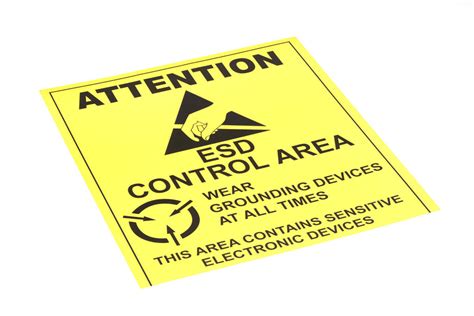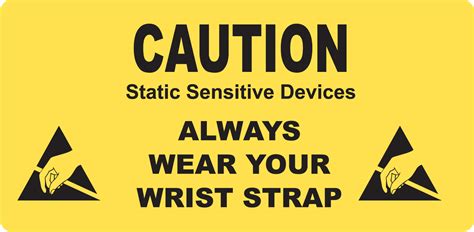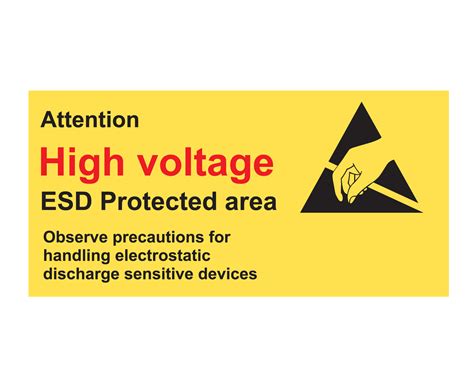Understanding Electrostatic Discharge (ESD)
Before diving into ESD-prevention techniques, it’s essential to understand what ESD is and how it occurs. Electrostatic discharge is the sudden flow of electricity between two objects with different electrical charges. This rapid transfer of electrons can generate high voltages and currents, which can damage or destroy sensitive electronic components.
ESD can occur in several ways, including:
- Direct contact between charged objects
- Induction between charged objects and conductive surfaces
- Electrostatic fields generated by charged objects
The severity of ESD damage depends on factors such as the voltage level, the sensitivity of the electronic components, and the duration of the discharge.
The Importance of ESD Prevention
Implementing ESD-prevention techniques is crucial for several reasons:
-
Protecting sensitive components: Many modern electronic devices contain components that are highly sensitive to ESD, such as microprocessors, memory chips, and sensors. Even a small electrostatic discharge can damage these components, leading to product failure or reduced performance.
-
Ensuring product reliability: ESD damage can cause latent defects in electronic devices, which may not be immediately apparent but can lead to premature failure or reduced reliability over time. By preventing ESD, manufacturers can improve product quality and reduce warranty claims.
-
Reducing costs: ESD damage can result in increased scrap rates, rework, and repair costs. Implementing effective ESD-prevention techniques can help minimize these costs and improve overall profitability.
-
Meeting industry standards: Many industries, such as aerospace, automotive, and medical devices, have strict ESD-prevention requirements. Failing to meet these standards can result in lost business opportunities and damage to a company’s reputation.

Common ESD-Prevention Techniques
There are several common ESD-prevention techniques that can be used to protect electronic devices and components. These techniques can be broadly categorized into four areas: grounding, shielding, neutralization, and packaging.
Grounding Techniques
Grounding is one of the most fundamental ESD-prevention techniques. It involves creating a low-resistance path between conductive objects and a common ground point, allowing electrostatic charges to dissipate safely. Some common grounding techniques include:
-
ESD wrist straps: These straps consist of a conductive band worn around the wrist and connected to ground through a resistor. They ensure that the operator’s body is at the same electrical potential as the workstation, preventing ESD from damaging sensitive components.
-
ESD flooring and mats: Conductive or dissipative flooring and mats help to ground personnel and equipment, minimizing the buildup of electrostatic charges. These materials are designed to safely dissipate charges to ground, reducing the risk of ESD events.
-
Grounding bars and points: Grounding bars and points provide a convenient way to connect equipment and materials to ground. They are typically located at workstations and throughout the production area to ensure that all conductive objects are properly grounded.
Shielding Techniques
Shielding involves creating a barrier between sensitive components and potential ESD sources. This can be achieved through the use of conductive materials that enclose or surround the components, effectively blocking electrostatic fields. Some common shielding techniques include:
-
Faraday cages: A Faraday cage is an enclosure made of conductive material that surrounds sensitive components, shielding them from external electrostatic fields. These cages can be built into equipment housings, cabinets, or even entire rooms.
-
Conductive bags and containers: Sensitive components can be stored and transported in conductive bags or containers, which provide shielding against ESD. These bags are made from materials such as metallized plastic or carbon-filled polyethylene and are designed to dissipate charges safely.
-
Shielded cables and connectors: Using shielded cables and connectors can help to minimize the coupling of electrostatic fields into sensitive circuits. The shield is typically connected to ground, providing a low-resistance path for any induced charges to dissipate.
Neutralization Techniques
Neutralization involves reducing the buildup of electrostatic charges on objects and personnel. This can be achieved through the use of ionizers, which generate positive and negative ions that neutralize charged surfaces. Some common neutralization techniques include:
-
Bench-top ionizers: These ionizers are designed to be placed on a workbench or other surface, providing localized neutralization of charges. They typically use a fan to circulate ionized air over the work area, effectively neutralizing any charged objects.
-
Room ionization systems: Larger production areas can be equipped with room ionization systems, which distribute ionized air throughout the space. These systems can help to maintain a neutral electrical environment, reducing the risk of ESD events.
-
Ionizing blowers and nozzles: Ionizing blowers and nozzles can be used to direct a stream of ionized air at specific objects or areas, providing targeted neutralization of charges. These devices are particularly useful for neutralizing charges on larger objects or hard-to-reach areas.
Packaging Techniques
Proper packaging is essential for protecting sensitive components during storage and transportation. ESD-safe packaging materials are designed to shield components from electrostatic fields and dissipate any charges that may build up. Some common packaging techniques include:
-
ESD-safe bags and containers: As mentioned earlier, conductive bags and containers provide shielding against ESD. These materials are also used for packaging components, ensuring that they remain protected until they are ready for use.
-
Foam and cushioning materials: ESD-safe foam and cushioning materials can be used to protect components from physical damage during transportation. These materials are typically made from conductive or dissipative polymers that help to dissipate any charges that may build up.
-
Moisture barrier bags: Moisture barrier bags, also known as dry packs, are used to protect components from moisture damage during storage and transportation. These bags are made from materials that prevent moisture ingress and often include desiccants to absorb any residual moisture.

Implementing an ESD-Prevention Program
To effectively protect electronic devices and components from ESD damage, it’s essential to implement a comprehensive ESD-prevention program. This program should include the following elements:
-
ESD training: All personnel who handle sensitive components should receive regular ESD training. This training should cover the basics of ESD, the potential risks, and the proper use of ESD-prevention techniques and equipment.
-
ESD-safe workstations: Workstations where sensitive components are handled should be designed to minimize the risk of ESD. This includes the use of ESD-safe flooring, mats, and grounding points, as well as the proper arrangement of equipment and materials.
-
ESD monitoring and testing: Regular monitoring and testing of ESD-prevention equipment and materials is essential to ensure their effectiveness. This can include resistance testing of wrist straps and flooring, as well as the use of ESD event detectors to identify potential problems.
-
ESD audits: Periodic audits of the ESD-prevention program can help to identify areas for improvement and ensure that all personnel are following proper procedures. These audits should cover all aspects of the program, from training and equipment to packaging and handling procedures.

Frequently Asked Questions (FAQ)
-
What is the difference between conductive and dissipative materials?
Conductive materials have a low electrical resistance, typically less than 10^4 ohms, and allow charges to flow easily. Dissipative materials have a higher resistance, usually between 10^4 and 10^11 ohms, and allow charges to dissipate more slowly. Both types of materials are used in ESD-prevention applications, depending on the specific requirements. -
Can ESD damage occur even if I don’t feel a shock?
Yes, ESD damage can occur without a visible or tangible shock. In fact, many ESD events that damage sensitive components are below the human perception threshold. This is why it’s essential to use proper ESD-prevention techniques, even if you don’t feel a discharge. -
How often should I replace my ESD-prevention equipment?
The lifespan of ESD-prevention equipment varies depending on the type of equipment and the frequency of use. In general, wrist straps should be tested daily and replaced if they fail to meet resistance specifications. Flooring and mats should be tested regularly and replaced if they show signs of wear or damage. Ionizers should be cleaned and calibrated according to the manufacturer’s recommendations. -
Can I use regular plastic bags for storing sensitive components?
No, regular plastic bags are not suitable for storing sensitive components, as they can generate and hold static charges. Instead, use ESD-safe bags or containers that are specifically designed for protecting components from ESD. -
What should I do if I suspect that a component has been damaged by ESD?
If you suspect that a component has been damaged by ESD, it should be immediately isolated and marked as potentially damaged. The component should then be tested to determine the extent of the damage. In some cases, the component may still be usable, but it may have reduced performance or reliability. If the damage is severe, the component should be discarded and replaced.
Conclusion
Electrostatic discharge (ESD) poses a significant risk to sensitive electronic components, and implementing effective ESD-prevention techniques is crucial for protecting these devices. By understanding the basics of ESD and applying common prevention techniques, such as grounding, shielding, neutralization, and proper packaging, manufacturers can minimize the risk of ESD damage and ensure the reliability and performance of their products.
Implementing a comprehensive ESD-prevention program, including regular training, ESD-safe workstations, monitoring and testing, and periodic audits, is essential for maintaining a high level of ESD protection. By following best practices and staying up-to-date with the latest ESD-prevention technologies, manufacturers can safeguard their products and maintain a competitive edge in today’s rapidly evolving electronics industry.

No responses yet